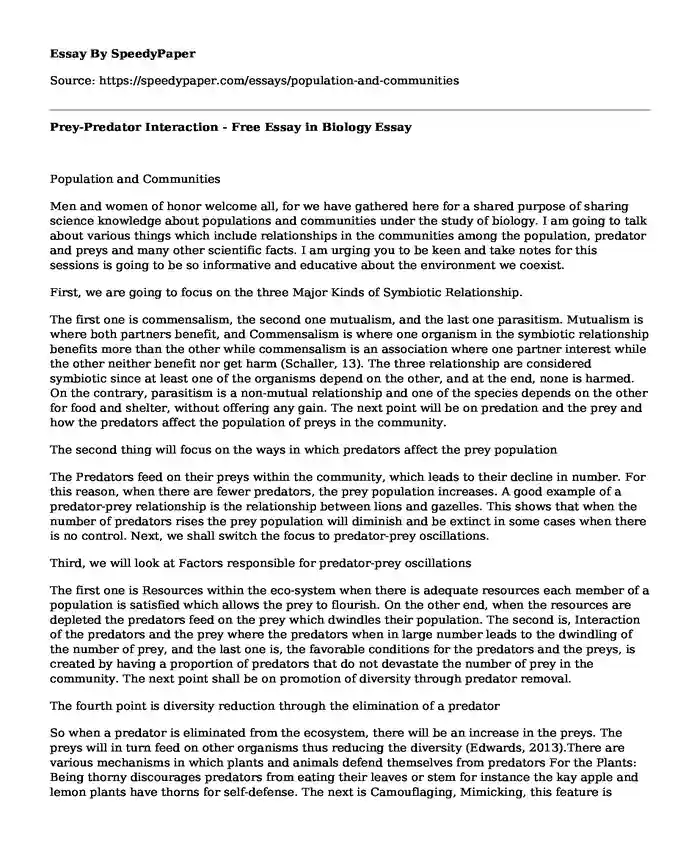Population and Communities
Men and women of honor welcome all, for we have gathered here for a shared purpose of sharing science knowledge about populations and communities under the study of biology. I am going to talk about various things which include relationships in the communities among the population, predator and preys and many other scientific facts. I am urging you to be keen and take notes for this sessions is going to be so informative and educative about the environment we coexist.
First, we are going to focus on the three Major Kinds of Symbiotic Relationship.
The first one is commensalism, the second one mutualism, and the last one parasitism. Mutualism is where both partners benefit, and Commensalism is where one organism in the symbiotic relationship benefits more than the other while commensalism is an association where one partner interest while the other neither benefit nor get harm (Schaller, 13). The three relationship are considered symbiotic since at least one of the organisms depend on the other, and at the end, none is harmed. On the contrary, parasitism is a non-mutual relationship and one of the species depends on the other for food and shelter, without offering any gain. The next point will be on predation and the prey and how the predators affect the population of preys in the community.
The second thing will focus on the ways in which predators affect the prey population
The Predators feed on their preys within the community, which leads to their decline in number. For this reason, when there are fewer predators, the prey population increases. A good example of a predator-prey relationship is the relationship between lions and gazelles. This shows that when the number of predators rises the prey population will diminish and be extinct in some cases when there is no control. Next, we shall switch the focus to predator-prey oscillations.
Third, we will look at Factors responsible for predator-prey oscillations
The first one is Resources within the eco-system when there is adequate resources each member of a population is satisfied which allows the prey to flourish. On the other end, when the resources are depleted the predators feed on the prey which dwindles their population. The second is, Interaction of the predators and the prey where the predators when in large number leads to the dwindling of the number of prey, and the last one is, the favorable conditions for the predators and the preys, is created by having a proportion of predators that do not devastate the number of prey in the community. The next point shall be on promotion of diversity through predator removal.
The fourth point is diversity reduction through the elimination of a predator
So when a predator is eliminated from the ecosystem, there will be an increase in the preys. The preys will in turn feed on other organisms thus reducing the diversity (Edwards, 2013).There are various mechanisms in which plants and animals defend themselves from predators For the Plants: Being thorny discourages predators from eating their leaves or stem for instance the kay apple and lemon plants have thorns for self-defense. The next is Camouflaging, Mimicking, this feature is common among plants that assume the color of their surface to avoid predators for instance Fastia Japonica. And for the Animals; running for example the cheetah and the kangaroo as fast enough to escape their predator, Camouflaging, and Hiding, which leads us to the next point.
The fifth point is the relationship of Batesian mimic to their model
Batesian mimic is where a harmless species evolves to copy the warning signal of the harmful species (Aubier, 272). It relates to the model in that they both are geared for the safety by the predator, which lead us to the sixth point. For instance, the conspicuous coloration is mimic by an organism which is harmless. The predator which make the prey for the model it has mimicked and leave it alone.
Our sixth point is the relationship between Mullerian mimic and its model
Mullerian mimicry is a natural situation whereby two more distasteful species that might be closely related and have common predators and have mimic each other way of the warning signal. This shows its relation to its model. This way a predator will avoid to harm the two species due to their similar warning signs even when they are not related. This relationship leads us to the last point.
Our last point is the reasons for succession
Ecological succession is the stage of change in the species of the structure on an ecological set up over some period (Pannell, 24). Succession takes place because the previous ecological system of the species has changed or has been disrupted. Thank you for listening.
Work Cited
Aubier, Thomas G., Mathieu Joron, and Thomas N. Sherratt. "Mimicry among unequally defended prey should be mutualistic when predators sample optimally." The American Naturalist 189.3 (2017): 267-282.
Edwards, Eric C., Dong-Hun Go, and Reza Oladi. "Prey-Predator Interaction in a Bioresource Economy and the Role of Free Trade." (2017).
Pannell, John R., and Edward E. Farmer. "Mimicry in plants." Current Biology 26.17 (2016): R784-R785.
Schaller, George B. The Serengeti lion: a study of predator-prey relations. University of Chicago Press, 2009.
Cite this page
Prey-Predator Interaction - Free Essay in Biology. (2017, Aug 09). Retrieved from https://speedypaper.net/essays/population-and-communities
Request Removal
If you are the original author of this essay and no longer wish to have it published on the SpeedyPaper website, please click below to request its removal:
- Prosocial Behavior Research Paper Samples
- Discretionary Action Research Paper Example for Free
- Role of Government in Tourism and Events, Essay Example for Students
- Article Analysis Essay: Son Charged With Murder in Death of Connecticut Couple
- Article Reviews Essay Example
- Issues in Electronic Health Records (EHR)
- Essay Sample on Cognitive Development Experiment
Popular categories





